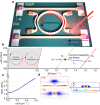Optomechanical ring resonator for efficient microwave-optical frequency conversion
- PMID: 37990000
- PMCID: PMC10663453
- DOI: 10.1038/s41467-023-43393-x
Optomechanical ring resonator for efficient microwave-optical frequency conversion
Abstract
Phonons traveling in solid-state devices are emerging as a universal excitation for coupling different physical systems. Phonons at microwave frequencies have a similar wavelength to optical photons in solids, enabling optomechanical microwave-optical transduction of classical and quantum signals. It becomes conceivable to build optomechanical integrated circuits (OMIC) that guide both photons and phonons and interconnect photonic and phononic devices. Here, we demonstrate an OMIC including an optomechanical ring resonator (OMR), where co-resonant infrared photons and GHz phonons induce significantly enhanced interconversion. The platform is hybrid, using wide bandgap semiconductor gallium phosphide (GaP) for waveguiding and piezoelectric zinc oxide (ZnO) for phonon generation. The OMR features photonic and phononic quality factors of >1 × 105 and 3.2 × 103, respectively. The optomechanical interconversion between photonic modes achieved an internal conversion efficiency [Formula: see text] and a total device efficiency [Formula: see text] at a low acoustic pump power of 1.6 mW. The efficient conversion in OMICs enables microwave-optical transduction for quantum information and microwave photonics applications.
© 2023. The Author(s).
Conflict of interest statement
The authors declare no competing interests.
Figures




References
-
- Delsing P, et al. The 2019 surface acoustic waves roadmap. J. Phys. D Appl. Phys. 2019;52:353001. doi: 10.1088/1361-6463/ab1b04. - DOI
-
- Dahmani YD, Sarabalis CJ, Jiang W, Mayor FM, Safavi-Naeini AH. Piezoelectric transduction of a wavelength-scale mechanical waveguide. Phys. Rev. Appl. 2020;13:24069. doi: 10.1103/PhysRevApplied.13.024069. - DOI
-
- Mayor FM, et al. Gigahertz phononic integrated circuits on thin-film lithium niobate on sapphire. Phys. Rev. Appl. 2021;15:014039. doi: 10.1103/PhysRevApplied.15.014039. - DOI
-
- Xu X-B, et al. High-frequency traveling-wave phononic cavity with sub-micron wavelength. Appl. Phys. Lett. 2022;120:163503. doi: 10.1063/5.0086751. - DOI
Grants and funding
LinkOut - more resources
Full Text Sources
Miscellaneous

